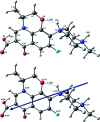Sustainable waste management and recycling of Zn-Al layered double hydroxide after adsorption of levofloxacin as a safe anti-inflammatory nanomaterial
- PMID: 35516965
- PMCID: PMC9055605
- DOI: 10.1039/d0ra04898d
Sustainable waste management and recycling of Zn-Al layered double hydroxide after adsorption of levofloxacin as a safe anti-inflammatory nanomaterial
Erratum in
-
Correction: Sustainable waste management and recycling of Zn-Al layered double hydroxide after adsorption of levofloxacin as a safe anti-inflammatory nanomaterial.RSC Adv. 2020 Aug 6;10(49):29128. doi: 10.1039/d0ra90083d. eCollection 2020 Aug 5. RSC Adv. 2020. PMID: 35532482 Free PMC article.
Abstract
Inorganic nano-layered double hydroxide (LDH) materials are used in the catalytic field, and have demonstrated great applicability in the pharmacological fields. In the current study, we report Zn-Al LDH as an adsorbent for levofloxacin (levo). The physical and chemical properties of the prepared material before and after adsorption were monitored using X-ray diffraction, Fourier-transform infrared (FT-IR) spectroscopic analysis, energy dispersive X-ray spectroscopy (EDX), Brunauer-Emmett-Teller (BET) surface area measurements, high-resolution transmission electron microscopy (HRTEM), and field emission scanning electron microscopy (FESEM). Density functional theory (DFT) calculations for levo and its protonated species were studied at the B3LYP/6-311G (d,p) level of theory. The removal percentage of levo was 73.5%. The adsorption isotherm was investigated using nine different models at pH 9, where the obtained correlation coefficients (R 2) using the Redlich-Peterson and Toth models were 0.977. The thermodynamic parameters ΔS°, ΔG° and ΔH° were estimated and discussed in detail. Also, to support the adsorption research field, the applicability of the formed waste after the adsorption of levo onto Zn-Al LDH was investigated for medical purposes. The toxicity of levo in both normal and nanocomposite form was studied. Neither toxicological symptoms nor harmless effects were exhibited throughout the in vivo study. The oral anti-inflammatory activity, tested using 6% formalin to produce edema in the footpad, was manifested as a significant increase of 37% in the anti-inflammatory effect of the Zn-Al LDH/levo nanocomposite compared to levo in its normal form.
This journal is © The Royal Society of Chemistry.
Conflict of interest statement
The authors confirm that there are no conflicts of interest associated with this publication.
Figures

















Similar articles
-
Chemisorption and sustained release of cefotaxime between a layered double hydroxide and polyvinyl alcohol nanofibers for enhanced efficacy against second degree burn wound infection.RSC Adv. 2020 Apr 1;10(22):13196-13214. doi: 10.1039/c9ra08355c. eCollection 2020 Mar 30. RSC Adv. 2020. PMID: 35492140 Free PMC article.
-
Exploitation of new approach to control of environmental pathogenic bacteria causing bovine clinical mastitis using novel anti-biofilm nanocomposite.Environ Sci Pollut Res Int. 2020 Dec;27(34):42791-42805. doi: 10.1007/s11356-020-10054-1. Epub 2020 Jul 28. Environ Sci Pollut Res Int. 2020. PMID: 32725561
-
Cross-linked bionanocomposites of hydrolyzed guar gum/magnetic layered double hydroxide as an effective sorbent for methylene blue removal.Carbohydr Polym. 2021 Apr 1;257:117628. doi: 10.1016/j.carbpol.2021.117628. Epub 2021 Jan 10. Carbohydr Polym. 2021. PMID: 33541654
-
Recent advances in the use of graphene-family nanoadsorbents for removal of toxic pollutants from wastewater.Adv Colloid Interface Sci. 2014 Feb;204:35-56. doi: 10.1016/j.cis.2013.12.005. Epub 2013 Dec 26. Adv Colloid Interface Sci. 2014. PMID: 24412086
-
Novel synthesis of Ni/Fe layered double hydroxides using urea and glycerol and their enhanced adsorption behavior for Cr(VI) removal.Sci Rep. 2020 Jan 17;10(1):587. doi: 10.1038/s41598-020-57519-4. Sci Rep. 2020. PMID: 31953466 Free PMC article.
Cited by
-
Actinobacterium-Mediated Green Synthesis of CuO/Zn-Al LDH Nanocomposite Using Micromonospora sp. ISP-2 27: A Synergistic Study that Enhances Antimicrobial Activity.ACS Omega. 2024 Aug 2;9(32):34507-34529. doi: 10.1021/acsomega.4c02133. eCollection 2024 Aug 13. ACS Omega. 2024. PMID: 39157139 Free PMC article.
-
Understanding the physicochemical properties of Zn-Fe LDH nanostructure as sorbent material for removing of anionic and cationic dyes mixture.Sci Rep. 2021 Nov 1;11(1):21365. doi: 10.1038/s41598-021-00437-w. Sci Rep. 2021. PMID: 34725383 Free PMC article.
-
New insight on some selected nanoparticles as an effective adsorbent toward diminishing the health risk of deltamethrin contaminated water.PLoS One. 2021 Nov 4;16(11):e0258749. doi: 10.1371/journal.pone.0258749. eCollection 2021. PLoS One. 2021. PMID: 34735469 Free PMC article.
-
Characterization of chitosan- and β-cyclodextrin-modified forms of magnesium-doped hydroxyapatites as enhanced carriers for levofloxacin: loading, release, and anti-inflammatory properties.RSC Adv. 2024 May 24;14(24):16991-17007. doi: 10.1039/d4ra02144d. eCollection 2024 May 22. RSC Adv. 2024. PMID: 38799215 Free PMC article.
-
Synthesis of Chitosan/Diatomite Composite as an Advanced Delivery System for Ibuprofen Drug; Equilibrium Studies and the Release Profile.ACS Omega. 2021 May 13;6(20):13406-13416. doi: 10.1021/acsomega.1c01514. eCollection 2021 May 25. ACS Omega. 2021. PMID: 34056488 Free PMC article.
References
LinkOut - more resources
Full Text Sources

